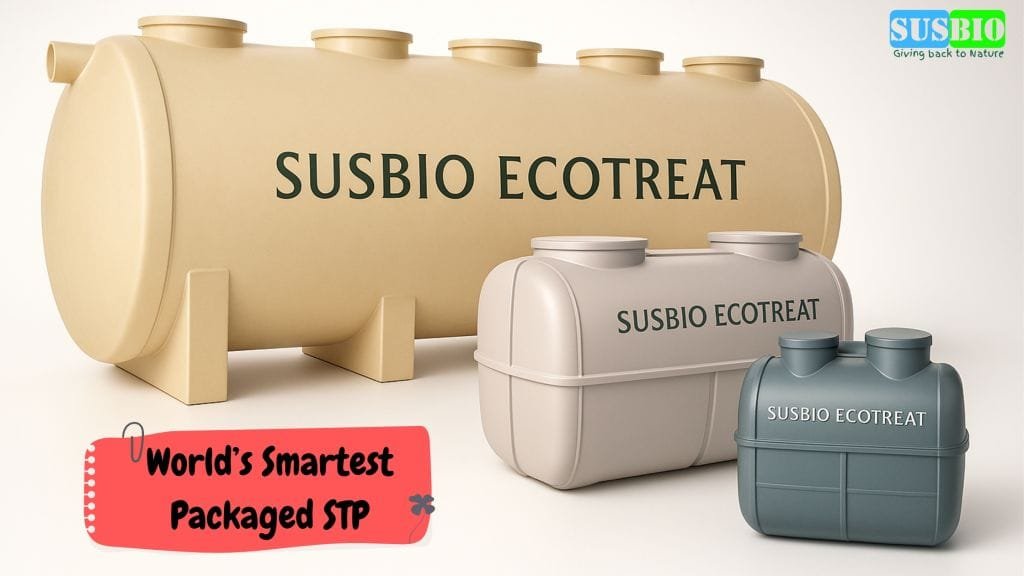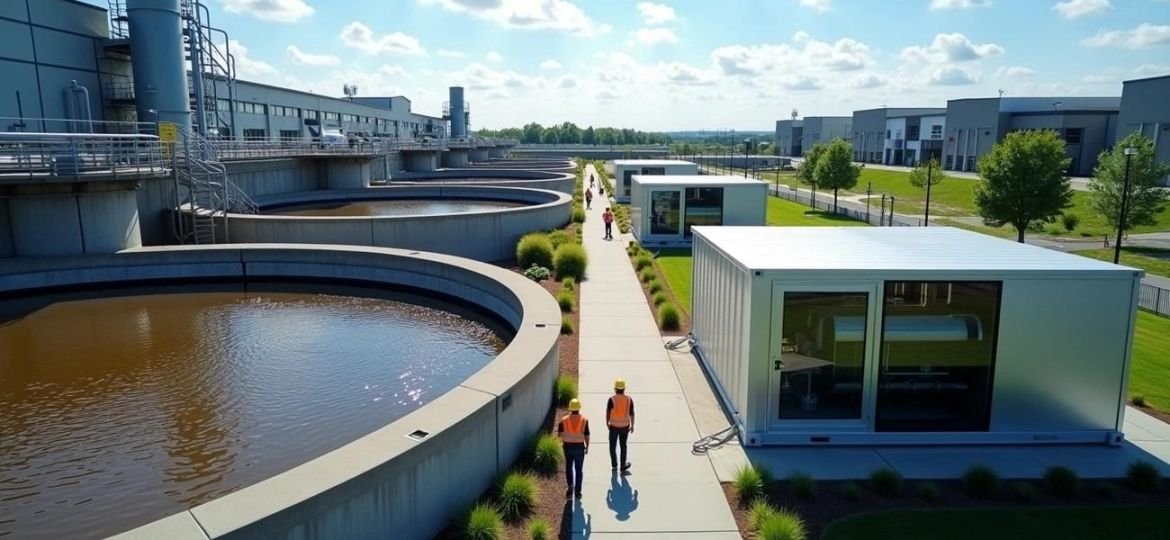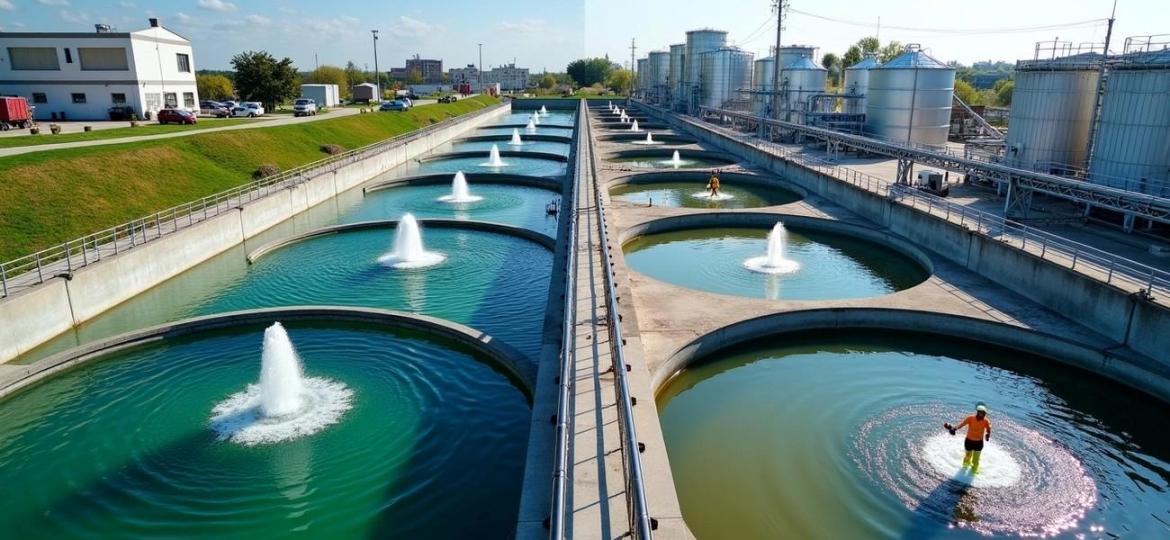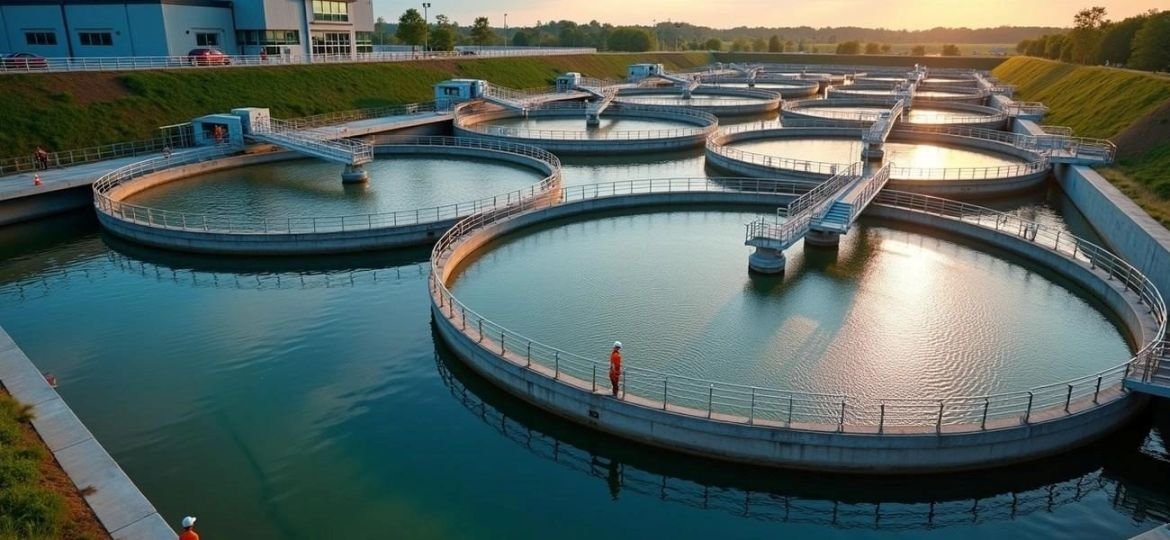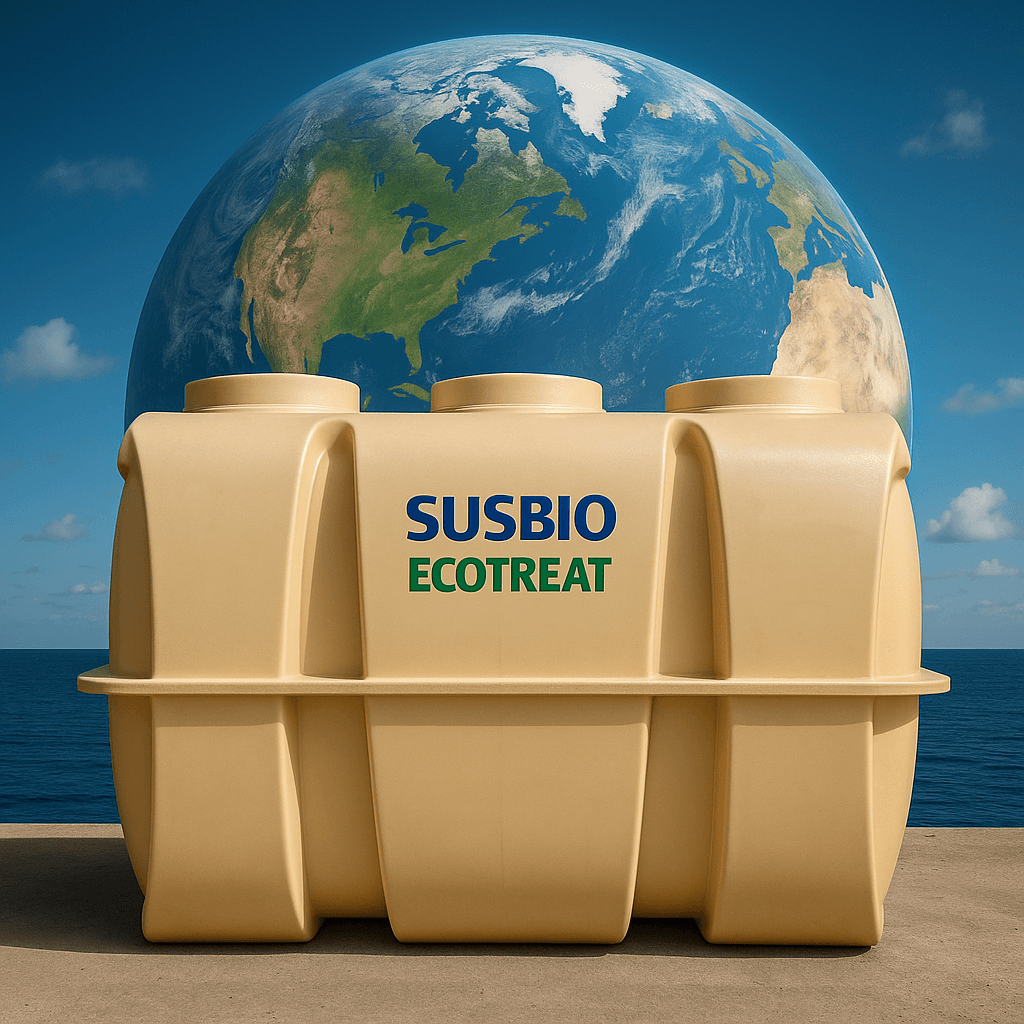Urban wastewater management in India faces a critical challenge. The country generates over 72,000 million liters of urban wastewater daily, yet treatment remains nowhere near 30% effective. These numbers explain the urgent need for groundbreaking solutions as we approach 2030.
The world’s water requirements will surge from 4,500 billion cubic meters today to 6,900 billion cubic meters by 2030—40% above our current available supply. The Central Pollution Control Board has set strict new discharge standards for all sewage treatment plants, which take effect in 2025. The water industry adopts new technologies slower than other sectors, but state-of-the-art wastewater treatment in India now moves forward rapidly.
This piece breaks down the changing world of green water and wastewater management. We focus on five major trends that revolutionize the sector: nutrient removal and recovery, energy conservation, green initiatives, trace organic compound treatment, and community involvement. These advances can help achieve ambitious targets like Gujarat’s goal to reuse 100% of treated wastewater by 2030.
Policy Frameworks Driving Sustainable Wastewater Management in India
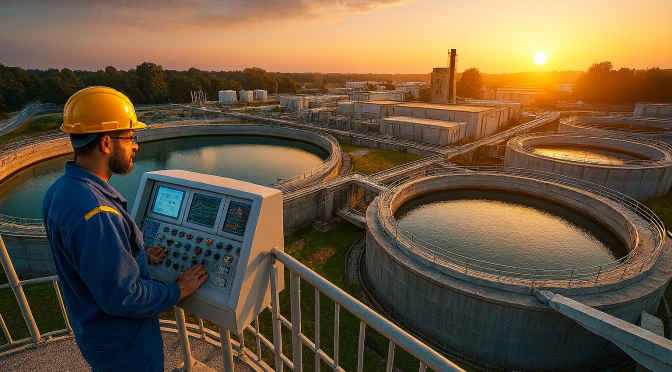
India’s wastewater management policies continue to develop with detailed frameworks that tackle the growing problems of water shortage and pollution. The country treats and uses only 20,235 MLD of the 72,368 MLD sewage it generates. The remaining 52,133 MLD gets discharged untreated, which creates an immediate need for better policies.
National Water Policy 2012 and Urban Reuse Mandates
The 2012 National Water Policy made water recycling and reuse a standard practice. It requires treatment to meet specific standards before reuse. The policy introduced a planned tariff system to encourage treated water usage in industries and agriculture. It also promotes the reuse of urban wastewater from kitchens and bathrooms. This water must undergo primary treatment for toilet flushing with no human contact.
The Department of Water Resources created a National Framework on Reuse of Treated Waste Water to help states develop their policies. States can use this framework as a template to create reuse policies with specific timelines.
CPCB 2025 Discharge Norms: BOD, COD, and Nitrogen Limits
The Central Pollution Control Board has set strict standards for sewage treatment plants, especially in metro cities. Cities with populations over 10 million must meet these standards:
- BOD: ≤10 mg/L
- COD: ≤50 mg/L
- TSS: ≤20 mg/L
- Total Nitrogen: ≤10 mg/L
- Fecal Coliforms: 100 MPN/100 mL (desirable)
Other regions need to maintain BOD at ≤20 mg/L and TSS at ≤50 mg/L. The National Green Tribunal has also specified that BOD should not exceed 30 mg/L and fecal coliforms must stay below 1000 MPN/100 mL. These standards help ensure safe reuse of treated wastewater for irrigation, industrial use, and urban landscaping.
State-Level Reuse Targets: Gujarat and Maharashtra Case
Some states lead the way with ambitious policies to speed up water reuse. Gujarat’s groundbreaking policy tackles water scarcity through a detailed framework for wastewater recycling and reuse. The state plans to reuse 100% of treated wastewater by 2030. Industries and agriculture within 50 km of treatment plants must use this water. The policy creates legal requirements and offers incentives. Water-intensive industries like chemical, chip manufacturing, and textile must recycle their wastewater.
Maharashtra requires industries in urban areas to use treated wastewater. The state’s 2019 Water Policy includes reuse provisions but lacks clear operational steps. The state failed to meet its target of reusing 6,888 million liters of daily sewage across 71 urban areas by 2020 under existing policy rules.
Liquid Waste Management Rules 2025: Urban and Rural Scope
The Ministry of Environment, Forest and Climate Change created the Liquid Waste Management Rules, effective October 1, 2025. These rules create a standard framework for responsible liquid waste handling in urban and rural areas.
The Extended User Responsibility (EUR) framework forms the rules’ foundation. Large water consumers (using over 5,000 liters daily) must treat and reuse at least 20% of their wastewater by 2027-28, increasing to 50% by 2030-31. Bulk users and treatment facilities need to register and submit annual self-declarations by June 30. They must also send regular audit reports to a centralized CPCB portal.
These rules show promise but face challenges with tight timelines, different infrastructure capabilities across regions, and overlapping targets with other national missions. Success depends on addressing these issues through better training, financial planning, and stakeholder participation.
Decentralized and Modular Treatment Systems for Urban India
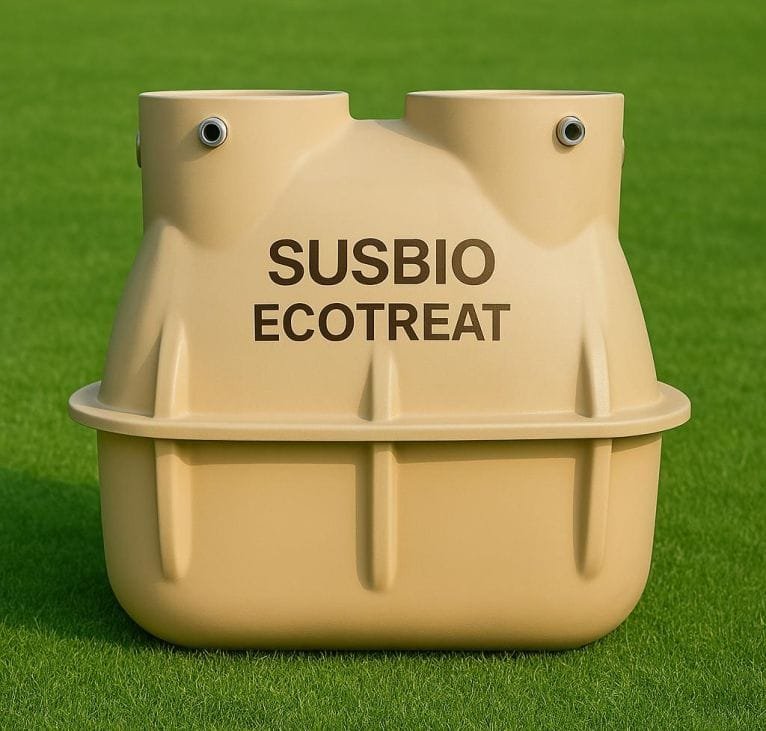
India’s urban growth has created an urgent need for wastewater solutions that work in small spaces. Local and modular treatment systems have become great alternatives to regular plants. These systems can treat water closer to where it’s generated.
Plug-and-Play STPs for Residential and Commercial Use
Packaged Sewage Treatment Plants (PSTPs) mark a big step forward in environmentally responsible wastewater management. These ready-to-use, pre-engineered systems match the performance of regular STPs but need 70% less space. They come pre-built from factories and are ready to install, which saves time and money.
Today’s PSTPs come with advanced features including:
- IoT-enabled FRP tanks for immediate monitoring
- Predictive maintenance to avoid breakdowns
- Advanced treatment processes (MBBR, SBR, and MBR technologies)
- Treatment capacities from 1 KLD to 1000 KLD
These systems are highly effective, removing 95-99% of BOD and COD. They also help recycle water for different uses, which supports circular water economy principles. The pre-built design delivers consistent quality and reliable results in buildings of all types—from homes to offices and factories.
Land-Saving Designs for High-Density Urban Areas
Space-saving designs have become practical answers for crowded cities. Multi-storey and underground STPs use 54% less land than traditional facilities. This matters because land scarcity and high costs often block wastewater infrastructure projects in cities.
Engineers now offer several space-smart options:
- Underground multi-storey STPs with double-layer designs
- Semi-underground systems with below-ground treatment
- Above-ground multi-storey designs with stacked processes
The numbers tell an impressive story. Traditional STPs need about 0.06 m² per population equivalent (PE), while compact systems need just 0.03 m² per PE. These space savings mean STPs can now fit in basements, on rooftops, and in small yards.
The designs also free up ground space for parks, parking, or other city amenities. This helps wastewater systems blend better into city landscapes.
Cost and Time Comparison with Traditional STPs
Modular systems offer benefits beyond just saving space. Projects finish up to 50% faster than traditional methods. Sites can be prepared while modules are being built at the same time.
The financial picture looks good too:
- Original building costs match traditional systems
- Running costs are much lower, using 30% less power
- Some new systems cut energy use by up to 90% through smart automation
- FRP construction means less maintenance
These benefits last throughout the system’s life. Factory-built STPs create less waste because materials can be recycled better. Shorter building times also mean less disruption, noise, and dust for nearby communities.
Space efficiency, quick setup, and lower running costs make these local and modular treatment systems an attractive choice for India’s growing cities.
Next-Gen Technologies Transforming Treatment Efficiency
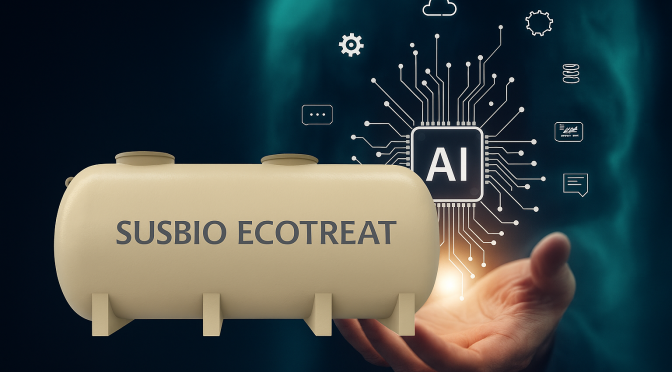
Breakthrough treatment methods are transforming sustainable wastewater management. These new technologies boost efficiency and resource recovery capabilities, which changes how treatment facilities work throughout India.
Dual-Phase Anaerobic-Aerobic Systems for BOD/COD Reduction
Dual-phase anaerobic-aerobic treatment systems remove pollutants remarkably well. This approach achieves COD removal rates of 80-90% with organic loading rates of 1.3-2.8 kg COD/m³ daily. The system’s anaerobic phase breaks down complex organics, and the aerobic phase polishes the effluent further. These systems can remove up to 98.9% BOD in the anaerobic zone and 99% in the aerobic zone, even with high-strength wastewater. The integrated A/O processes create 41.5% fewer negative environmental effects than standard activated sludge systems.
UV and Membrane Filtration for Tertiary Treatment
Advanced tertiary treatment technologies help water quality meet strict reuse standards. Ultrafiltration (UF) catches suspended particles, colloids, and microorganisms, while advanced oxidation processes remove more organic matter. Companies now choose membrane filtration and UV disinfection because they work so well in treating wastewater. These methods remove 99% of contaminants and produce high-quality reusable water. Zwitterionic membranes work better in high-foul environments. They filter out fats, oils, and proteins while cutting down cleaning and replacement costs.
IoT-Based Real-Time Monitoring and Predictive Maintenance
IoT integration changes how treatment plants operate by constantly checking critical factors like flow rates, pH, dissolved oxygen, and chemical dosing. These systems predict equipment wear and potential failures before they happen. This means maintenance happens only when needed, which cuts downtime, extends equipment life, and reduces costs. IoT-driven automation also adjusts operational settings based on immediate data, which ensures the best treatment efficiency.
Energy-Efficient Blowers and Pumps: 90% Energy Savings
Maglev turbo blowers work at over 90% efficiency. Their frictionless design uses much less energy than traditional blowers. Switching from oversized pumps to right-sized, high-efficiency designs can cut energy use by 3-20%, sometimes even up to 50%. Variable speed drives save 10% more energy by letting pumps adjust their speed for desired flow rates. Smart pump selection and optimization lead to big energy and cost savings throughout the system’s life.
Biogas Recovery from Sludge for Renewable Energy
Anaerobic digestion of sewage sludge creates biogas, which helps facilities become energy independent or sell power to local networks. This biological process turns organic waste into renewable energy and reduces sludge volume. Purified biogas (biomethane) can go into gas networks for home or industrial use, with purification reaching 99.5% efficiency. Biogas recovery shows how circular economy works by turning waste into value and cutting greenhouse gas emissions.
Overcoming Implementation Barriers in Wastewater Projects
Wastewater projects need well-planned strategies to succeed. Advanced technologies and supportive policies exist today. These projects still face practical barriers that slow down progress toward eco-friendly wastewater management.
Addressing Public Perception of Recycled Water
The public’s acceptance remains a major roadblock in wastewater reuse programs. Research shows psychological factors like the ‘yuck factor’ substantially affect how people view these initiatives. A person’s age plays a vital role in their understanding. Research found that 59% of people aged 18-20 didn’t know about water recycling treatment methods. The data showed that only 12.5% of people knew about low public acceptance of water reuse in activities with direct human contact. The quickest way to break these perception barriers starts with public education through simple and clear information sharing.
Single-Window Governance and Online Compliance Portals
Wastewater management becomes complex because of governance structures in sectors of all sizes and government levels. Single-window portals are a great way to get past these challenges. Tamil Nadu’s Single Window Portal shows how well this works. The portal handles more than 200 services from over 30 government departments and has approved 25,140 applications. Users can submit supporting documents, receive authority queries, and track their applications. This system ended up making government-to-business interactions faceless, paperless, and contactless—which improved business operations.
Financing Models: Green Bonds, PPPs, and Tax Incentives
Innovative financing options have become vital for developing wastewater infrastructure. Green bonds changed development finance completely. Global issuance grew by 49% between 2018-2019 and reached about INR 21,517.01 billion. These bonds help raise capital specifically for projects that benefit the environment. On top of that, Public-Private Partnerships work well for wastewater treatment projects, especially through build-operate-transfer contracts. These financing approaches help overcome high original investment needs while using expertise from both public and private sectors.
Future Trends in Sustainable Wastewater Management 2030
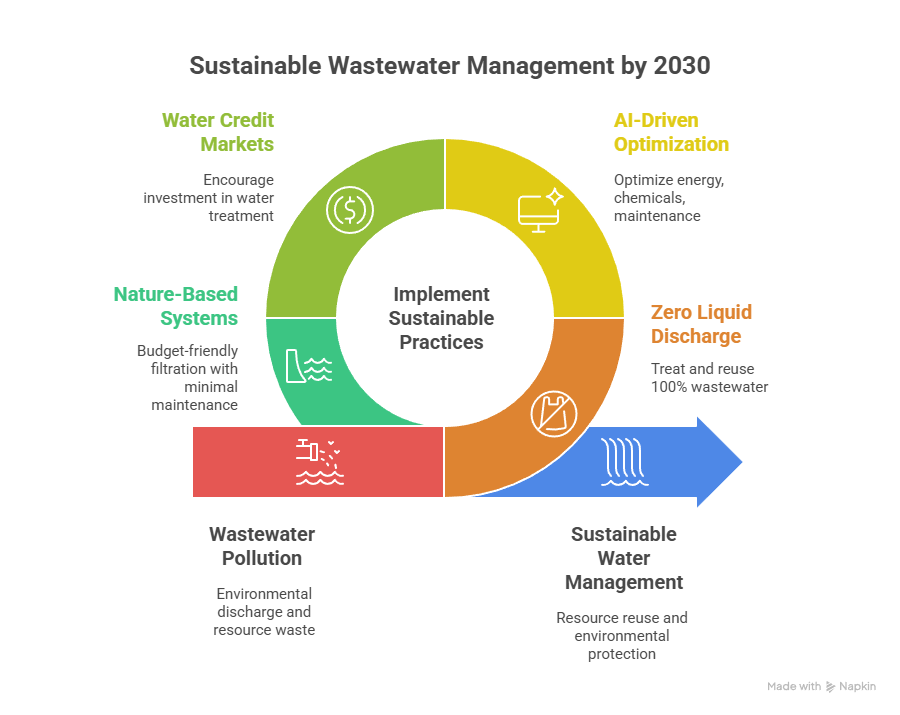
India’s wastewater sector will transform significantly by 2030. New approaches focus on sustainability and better resource use.
Zero Liquid Discharge (ZLD) for Industrial Clusters
The global ZLD market will grow faster, reaching INR 987.25 billion by 2030 from INR 540.03 billion in 2023, with an 8.8% CAGR. ZLD systems help industries treat and reuse 100% of their wastewater without environmental discharge. Surat Municipal Corporation leads this change and plans to achieve 50% reuse by 2025 and complete reuse by 2030.
AI-Driven Optimization in STP Operations
AI technology transforms treatment plant management through predictive analytics that optimize energy use, chemical dosage, and maintenance schedules. Modern systems monitor parameters and adjust operations based on up-to-the-minute data analysis. AI-driven equipment optimization has helped facilities save up to 90% energy.
Water Credit Markets and Circular Economy Integration
New water credit trading systems allow treated water exchange between municipal, industrial, and agricultural users. This market approach encourages investment in advanced treatment and creates new revenue opportunities for urban local bodies.
Nature-Based Hybrid Systems for Rural Areas
Rural communities benefit from nature-based solutions like constructed wetlands that offer budget-friendly alternatives to conventional systems. These solutions use natural filtration processes and need minimal maintenance. They provide additional benefits like carbon capture and create natural habitats.
Conclusion
India’s environmentally responsible wastewater management faces a crucial turning point in 2030. This piece explores how traditional wastewater treatment methods have evolved substantially due to necessity and state-of-the-art solutions. The country treats nowhere near enough wastewater – less than 30% of 72,000 million liters generated daily. This reality demands ground-breaking solutions quickly.
National and state-level policy frameworks have set bold targets. Gujarat aims for complete wastewater reuse by 2030. These policies, combined with CPCB’s strict discharge standards coming in 2025, present new challenges and chances for growth in the sector.
Space-constrained urban environments benefit from decentralized treatment systems. These systems’ plug-and-play nature, smaller footprint, and similar costs make them attractive alternatives to conventional methods. Recent technological breakthroughs like dual-phase anaerobic-aerobic systems, advanced filtration methods, and IoT-based monitoring have improved treatment efficiency while using less energy.
The sector faces several obstacles. People remain skeptical about recycled water’s safety. Complex governance structures and financial challenges don’t deal very well with implementation needs. In spite of that, promising solutions emerge through single-window governance portals, green bonds, and strategic collaborations.
Tomorrow’s wastewater sector will see fundamental changes. Zero liquid discharge systems, AI-driven optimization, water credit markets, and nature-based solutions lead the way. These developments mark a change from seeing wastewater as waste to viewing it as a valuable resource in a circular economy.
Creating environmentally responsible wastewater management by 2030 definitely seems challenging. Yet India can turn this environmental challenge into a chance for resource recovery when we welcome state-of-the-art solutions, maintain policy support, and encourage public participation. These technologies and frameworks are the foundations of a more sustainable water future, not just quick fixes to a current problem.
Key Takeaways
India’s wastewater management sector is undergoing a revolutionary transformation driven by policy mandates, technological innovation, and urgent environmental needs as we approach 2030.
- Policy-driven transformation: Gujarat targets 100% wastewater reuse by 2030, while new CPCB discharge norms require BOD ≤10 mg/L for metro cities by 2025.
- Space-efficient solutions: Modular treatment systems reduce land requirements by 54% and deployment time by 50% compared to traditional plants.
- Energy revolution: Next-gen technologies like maglev blowers and AI optimization achieve up to 90% energy savings in treatment operations.
- Circular economy integration: Zero liquid discharge systems and biogas recovery transform waste into valuable resources, supporting energy autonomy goals.
- Implementation barriers persist: Public perception challenges and complex governance structures require innovative financing through green bonds and single-window portals.
The convergence of stringent regulations, advanced technologies, and innovative financing models positions India to transform its wastewater crisis into a sustainable resource management opportunity by 2030.
Frequently ASKED QUESTIONS
Q1. What are the key policy targets for sustainable wastewater management in India by 2030?
India has set ambitious targets, including Gujarat’s goal of 100% wastewater reuse by 2030. The Central Pollution Control Board has also introduced stringent discharge standards, requiring BOD levels of ≤10 mg/L for metro cities by 2025.
Q2. How are decentralized treatment systems improving urban wastewater management?
Decentralized systems offer significant advantages in urban areas, reducing land requirements by up to 54% and deployment time by 50% compared to traditional plants. These modular solutions are particularly effective in space-constrained environments.
Q3. What technological innovations are driving energy efficiency in wastewater treatment?
Next-generation technologies like maglev turbo blowers and AI-driven optimization are revolutionizing treatment plant operations, achieving up to 90% energy savings compared to conventional systems.
Q4. How is wastewater management contributing to the circular economy?
Wastewater management is increasingly adopting circular economy principles through zero liquid discharge systems and biogas recovery from sewage sludge. These approaches transform waste into valuable resources, supporting energy autonomy goals for treatment facilities.
Q5. What are the main challenges in implementing sustainable wastewater projects in India?
Key challenges include public perception of recycled water, complex governance structures, and financing barriers. Innovative solutions like single-window governance portals, green bonds, and public-private partnerships are being explored to address these obstacles.


